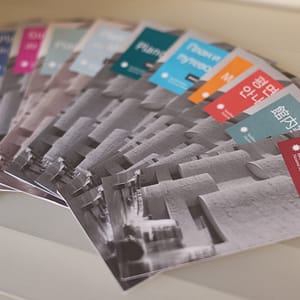How to Choose the Best Language Variant for Your Cultural Institution
Selecting the right languages for translation is challenging, but things get especially perplexing when a language has multiple forms. Language is fluid and evolves differently over time, and today many common languages have distinct linguistic variants.
It’s easy to understand the concept by considering the differences between British and American English. While they are the same language, hundreds of everyday words are different, and each form has distinctive grammar and spelling conventions that feel natural on one side of the Atlantic, but may provoke a smile or even an occasional moment of confusion on the other side.
To help, we describe a few of the more common variants and the way they are typically handled by U.S.-based museums, botanical gardens, zoos, and other cultural institutions.
Selecting the Right Spanish Variant
Many American museums and cultural institutions translate some or all of their materials into Spanish, because the language is so widely spoken throughout the country. More than 41 million U.S. residents speak Spanish as their first language. Another 11.6 million are bilingual, many of whom are the children of Spanish-speaking immigrants. These numbers are only predicted to grow. According to the U.S. Census Office, the country will have an estimated 138 million Spanish speakers by 2050, making it the largest Spanish-speaking nation in the world.
Any institution planning to translate into Spanish should be aware that the language has distinct variants. There are significant differences in vocabulary from one country to the next. Words that are common to one version of Spanish may have a completely different meaning in another locale.
It’s certainly not feasible to tailor every Spanish translation to the many different Spanish-speaking countries. If translating for residents of mainland Spain, Peninsular (or European) Spanish should be used, as this is the only variant that will fully resonate with this target market. However, this version is significantly different from what is spoken in the U.S. and throughout Latin America.
When to Use LATAM Spanish in Translations
For our American cultural clients, we typically recommend translating into either U.S. Spanish or Latin American Spanish (LATAM). The universal form of LATAM uses neutral versions of Spanish words that are not specific to any individual country. It is spoken with a neutral accent that one might associate with movie and TV dubbing or commercials.
U.S. Spanish is similar to neutral LATAM Spanish, but uses U.S. units of measurement and conventions for punctuation, such as using commas rather than decimal points to separate groups of thousands. It’s the form used by major international television cable channels such as CNN en Español and Univisión, where you might hear the weather reported in Fahrenheit rather than Celsius.
While LATAM and U.S. Spanish may not sound completely natural to people from all Spanish-speaking countries, they will be understood by all Spanish speakers, making either form an appropriate choice for many U.S. communities.
Cities like San Diego, Chicago, and Houston have large Mexican populations, and for a museum located in such an area, it may seem logical to translate into Mexican Spanish. However, unless the target audience is exclusively Mexican, this can be exclusionary to other groups. Rather, we typically advise using a variant that all groups will understand. This is the practice followed by most U.S. museums, who translate into either LATAM or U.S. Spanish.
The Difference Between Simplified and Traditional Chinese
While there are many varieties of spoken Chinese, including Mandarin and Cantonese, the standard written language has two variants: Simplified and Traditional. As its name suggests, Simplified Chinese incorporates simplified versions of the original Chinese characters. Traditional Chinese, on the other hand, retains the characters in their traditional forms. This divergence resulted from the Chinese Communist Party’s campaign to reduce illiteracy in the 1950s by promoting a simplified version of the writing system. Today, simplified characters remain the standard in mainland China and Singapore, while people in Hong Kong, Taiwan, and Macau continue to use traditional characters.
When a cultural institution is targeting tourists, we often advise translating materials into Simplified Chinese. There are 1.4 billion people in mainland China, as compared to 7 million people in Hong Kong and 23 million in Taiwan. And while tourism from China has varied significantly in recent years, with an eye to existing US populations as well as travelers present and future, Simplified Chinese is still usually the right choice.
One exception to this rule applies to institutions located in New York and San Francisco, a result of the early influx of Chinese immigrants to these areas. Chinese communities were established in these cities before the advent of Simplified Chinese and many residents still use the Traditional characters today. Therefore, many museums in New York and San Francisco translate into Traditional Chinese.
Cultural institutions that want to best accommodate all Chinese speakers, and have the resources to do so, will often translate into both Simplified and Traditional.
The Many Varieties of French
One of the fastest growing languages in the world, French is spoken by more than 275 million people worldwide, including 1.6 million people in the U.S. As with Spanish and Chinese, different groups have developed distinct dialects.
The standard version of French as it is spoken in France is taught in schools throughout the world. U.S.-based institutions will commonly translate into this form of French to make their materials accessible to French and other Francophone visitors.
However, it’s important to be aware of the many other variants. Canadian French is the correct form to use when translating specifically for Canadian audiences. The largest area of growth for the French language is in Africa. The International Organisation of La Francophonie estimates there will be 700 million French speakers in the world by 2050, with close to 80% living in Africa. Across the African continent, French is spoken with many local differences with regard to accents, slang and vocabulary. While French for France translations will not sound completely natural to all international visitors familiar with other variants, it is a form that all groups will understand.
Which Version of Portuguese Is Best for Translations?
With an estimated 220 million native speakers, Portuguese is an official language of 10 countries. It’s the sixth most spoken language in the world by number of native speakers and the second most spoken Romance language, after Spanish.
There are significant differences between the European version of Portuguese spoken in Portugal and the variant used in Brazil—not to mention those spoken in Africa or Asia. When selecting the appropriate form for translation, U.S. institutions will typically opt for Brazilian Portuguese. This is due to the numbers—Brazil has the largest population of native Portuguese speakers in the world, over 205 million, as compared to 10 million in Portugal.
Selecting the Right Variant for Your Audience
Understanding language variants can be tricky, but it’s important. Start by speaking with your translation provider. Discuss whom you are targeting and how your translations will be used. Your translation company will help you select the right variants for your target audiences and assign the appropriate linguists. A translator who is a native of Spain would be chosen to translate a piece developed for Spanish-speakers in Spain. Such a linguist would have the best command of the language and its nuances. Likewise, a resident of a Latin American country would be selected to translate into LATAM Spanish.
 Named to the 2024 Inc. 5000 list of fastest-growing companies and ranked among the world’s top 100 language service providers by CSA Research
Named to the 2024 Inc. 5000 list of fastest-growing companies and ranked among the world’s top 100 language service providers by CSA Research

